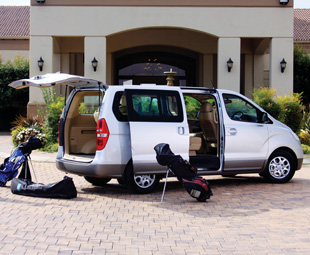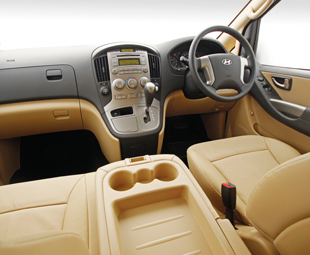Kicking off with Hyundai’s H1 diesel

As Hyundai continues to grow its market share, the company is establishing itself as a major competitor in the automotive industry. STUART MOIR finds out how the launch of the new H1 diesel will help consolidate Hyundai’s success.
Hyundai’s H1 diesel follows hot on the heels of the successful H1 petrol engine range, which was launched in March last year and reached peak sales at 90 units during the December period. This spacious nine-seater luxury wagon fought hard for a leading position in what is essentially a highly competitive up-market class of vehicle, winning a significant market share.
Not only is the diesel version perfectly priced and well-finished; it’s also a joy to drive. Having been given the opportunity to put the H1 diesel through its paces in a 100 km journey to the Vaal, I can understand why it is only once you are in the vehicle and on the road that you can appreciate the benefits of its size and power. Thanks to its sizeable mirrors, there are very few blind spots, optimising visibility. Together with rear-park distance control, this makes the H1 diesel pleasingly easy to park. The rack pinion ensures a crisp response, while hydraulic assistance reduces the effort required to negotiate tight situations: a must-have in a vehicle of this size.
Take a quick look at the features and specifications of the H1 2.5 VGTi and you’ll quickly realise that, for starters, it’s the only vehicle in its class offering leather as standard at such a competitive price. Other attractions include alloy wheels and air conditioning with fan-speed control for rear-seat passengers. At a more functional level, the H1 also comes standard with a full-size spare wheel.
Big brother of Hyundai’s all-terrain Sante Fe, the engine is equipped with a 2.5 l common-rail unit rated at 120 kW (3 800 r/min) and 392 Nm (2 000 r/min). In tandem with all the advantages of five-speed automatic transmission, the H1 diesel’s DOHC 16-valve cylinder head contributes towards exceptional fuel efficiency, using just 10 l per 100 km in mixed driving. An excellent drag co-efficient of 0:34 also contributes towards the vehicle’s impressive performance.
 In terms of safety layout, the H1 diesel boasts a series of reinforced rings aligned with key body pillars and linked across the vehicle’s floor and roof. Another feature is a substantial front crumple zone. The four-channel ABS and electronic fore-aft hydraulic pressure distribution system ensure maximum retardation, even when fully laden. Dual airbags and front seat belts equipped with pre-tensioners make provision for optimum safety in any driving conditions. Not surprisingly, when crash-tested by the Australasian New Car Assessment Programme (ANCAP), the H1 diesel achieved four out of a possible five-star rating, placing it near the front of its class.
In terms of safety layout, the H1 diesel boasts a series of reinforced rings aligned with key body pillars and linked across the vehicle’s floor and roof. Another feature is a substantial front crumple zone. The four-channel ABS and electronic fore-aft hydraulic pressure distribution system ensure maximum retardation, even when fully laden. Dual airbags and front seat belts equipped with pre-tensioners make provision for optimum safety in any driving conditions. Not surprisingly, when crash-tested by the Australasian New Car Assessment Programme (ANCAP), the H1 diesel achieved four out of a possible five-star rating, placing it near the front of its class.
With the same axle length as the Mercedes- Benz Vito, the H1 diesel can carry eight people in comfort without compromising its 850 l luggage compartment even when the rearmost seats are in use. Although Hyundai’s newcomer is primarily targeted at the hospitality industry, it is also an ideal vehicle for old age homes, corporate transport and large families. At R359 900 – including a 5-year/150 000 km warranty and 5-year/100 000 km service plan – the overall package is one of comfort, safety and convenience unmatched by any of its rivals in the same price range.
Marketing director of Hyundai Automotive South Africa, Stanley Anderson, says there has been a 53% improvement in Hyundai’s product quality. He also reveals that only Porsche and Lexus stand above Hyundai as best mass manufacturer in a recent survey.
With 87 dealerships nationwide, Hyundai currently occupies 12.2% of the market segment. The arrival of the H1 diesel is likely to improve this figure substantially.
Published by
Focus on Transport
focusmagsa




 !
From 1 Apri
!
From 1 Apri

 Big news from FOCUS on Transport + Logist
Big news from FOCUS on Transport + Logist





 FUSO: Driving the Future of Mobile Healthc
FUSO: Driving the Future of Mobile Healthc



 A brand
A brand




 Wondering about the maximum legal load for a
Wondering about the maximum legal load for a 
 The MAN hTGX powered by a hydrogen combus
The MAN hTGX powered by a hydrogen combus

 Exciting News for South African Operators
Exciting News for South African Operators
